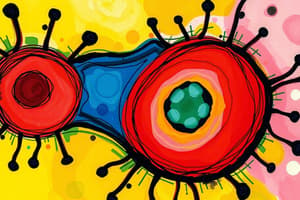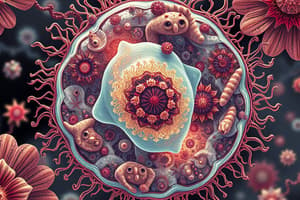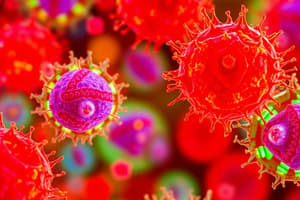Podcast
Questions and Answers
What is a key characteristic of prokaryotic cells?
What is a key characteristic of prokaryotic cells?
- They lack ribosomes.
- They contain membrane-bound organelles.
- They have a true nucleus.
- They are unicellular organisms (correct)
Which of the following correctly describes the role of the Golgi apparatus?
Which of the following correctly describes the role of the Golgi apparatus?
- It acts as the digestion machine in the cell.
- It produces proteins by assembling amino acids.
- It packages and transports lipids and proteins. (correct)
- It is the main control center of the cell.
Which statement accurately contrasts plant cells with animal cells?
Which statement accurately contrasts plant cells with animal cells?
- Animal cells can photosynthesize.
- Plant cells possess a cell wall and chloroplasts. (correct)
- Only animal cells contain centrioles.
- Only plant cells have ribosomes.
What function does the plasma membrane serve?
What function does the plasma membrane serve?
Which organelle is responsible for the breakdown of waste materials in the cell?
Which organelle is responsible for the breakdown of waste materials in the cell?
What is not a part of the cell theory?
What is not a part of the cell theory?
What distinguishes eukaryotic cells from prokaryotic cells?
What distinguishes eukaryotic cells from prokaryotic cells?
What is the primary function of ribosomes in the cell?
What is the primary function of ribosomes in the cell?
What role does the diaphragm play in a compound microscope?
What role does the diaphragm play in a compound microscope?
Which statement accurately reflects the contributions of Theodor Schwann to cell theory?
Which statement accurately reflects the contributions of Theodor Schwann to cell theory?
Which part of a compound microscope provides support and houses the light source?
Which part of a compound microscope provides support and houses the light source?
What does the second part of cell theory, stated by Rudolf Virchow, emphasize?
What does the second part of cell theory, stated by Rudolf Virchow, emphasize?
Who was the first to declare that all living things are made of cells?
Who was the first to declare that all living things are made of cells?
What feature distinguishes prokaryotic cells from eukaryotic cells?
What feature distinguishes prokaryotic cells from eukaryotic cells?
What component of a compound microscope is responsible for capturing light from an external source?
What component of a compound microscope is responsible for capturing light from an external source?
What was William Henry Perkin's contribution to the study of cells?
What was William Henry Perkin's contribution to the study of cells?
What is the primary function of the fine focus in a compound microscope?
What is the primary function of the fine focus in a compound microscope?
Which component of the microscope holds the objective lenses and permits rotation to change magnification?
Which component of the microscope holds the objective lenses and permits rotation to change magnification?
Which of the following correctly describes the function of the coarse focus?
Which of the following correctly describes the function of the coarse focus?
What role does the specimen stage play in the use of a microscope?
What role does the specimen stage play in the use of a microscope?
How does the body tube contribute to the function of a microscope?
How does the body tube contribute to the function of a microscope?
What is the typical magnifying power range of the objective lenses in a compound microscope?
What is the typical magnifying power range of the objective lenses in a compound microscope?
Which part of the microscope stabilizes the head and allows for adjustments during viewing?
Which part of the microscope stabilizes the head and allows for adjustments during viewing?
Which component of a microscope is primarily responsible for focusing at high power?
Which component of a microscope is primarily responsible for focusing at high power?
Flashcards are hidden until you start studying
Study Notes
Cell Basics
- All living organisms are composed of cells
- Cells originate from pre-existing cells.
- The cell is the fundamental unit of life.
- Cells are classified into two main categories: prokaryotic and eukaryotic.
Prokaryotic Cells
- Lack a true nucleus and membrane-bound organelles.
- Examples include bacteria.
- They are unicellular, comprised of a single cell.
Eukaryotic Cells
- Have a true nucleus and membrane-bound organelles.
- Include both multicellular organisms (animals and plants) and some single-celled organisms.
Cell Structures:
- Plasma membrane: A thin membrane surrounding cells and organelles, playing a vital role in regulating what enters and exits.
- Cytoplasm: Gel-like substance containing chemicals and organelles, supporting metabolic reactions, organelle movement, and structural support.
- Nucleus: The control center enclosed by a membrane, containing DNA, providing instructions for protein production and cell functions. It's crucial for cell division.
- Ribosomes: These are like construction workers, building proteins.
- Endoplasmic reticulum (ER): Functions as a manufacturing and packaging system, working with the Golgi apparatus and ribosomes. It produces and transports lipids, and packages proteins.
- Golgi apparatus: Also known as the Golgi complex, Golgi body, or simply the Golgi. It's the packaging organelle and packages vesicles.
- Lysosomes: Also known as "little digestion machines," they break down food particles, waste, and foreign substances within the cell.
- Centrioles: Found in animal cells, they help in cell division.
Plant Cell Specific Structures
- Cell wall: Made of cellulose, it provides structural support for plant cells.
- Chloroplasts: These are the food producers, carrying out photosynthesis.
Compound Microscope Components
- Stage clips: Hold slides in place during viewing.
- Illuminator: Provides light for viewing, replacing the traditional mirror.
- Diaphragm (also known as the iris): Controls the amount of light that reaches the specimen.
- Base: Offers stability, houses the light source, and provides a platform for microscope placement.
- Eyepiece: Contains the lens used for viewing, allowing comfortable observation.
- Body Tube: Holds the objective lenses and eyepiece at a fixed distance for proper viewing.
- Coarse Focus Knob: Moves the stage to bring the specimen into initial focus.
- Fine Focus knob: Refines the focus, often located within the coarse focus knob, for sharp viewing under different power levels.
- Objective Lenses: Magnify the specimen for detailed observation, ranging from 4x to 100x magnification.
- Body Tube: Holds the objective lenses and eyepiece in proper alignment.
- Revolving Nosepiece: Holds the objective lenses and allows rotation to select different magnifications.
- Arm: Connects the microscope head to the base, providing stability.
- Specimen Stage: Platform where the slide is placed for viewing.
Cell Theory
- Matthias Schleiden (1838): discovered that plants were made of cells through extensive microscopic observation.
- Theodor Schwann (1839): expanded Schleiden’s findings to animals, concluding that all living things are made of cells through his own microscopic studies.
- Rudolf Virchow (1858): proposed the principle that new cells arise from pre-existing cells, forming the second part of the cell theory.
Summary of Cell Theory
- All living organisms are composed of cells.
- All cells come from pre-existing cells.
- The cell is the fundamental unit of life.
Studying That Suits You
Use AI to generate personalized quizzes and flashcards to suit your learning preferences.




